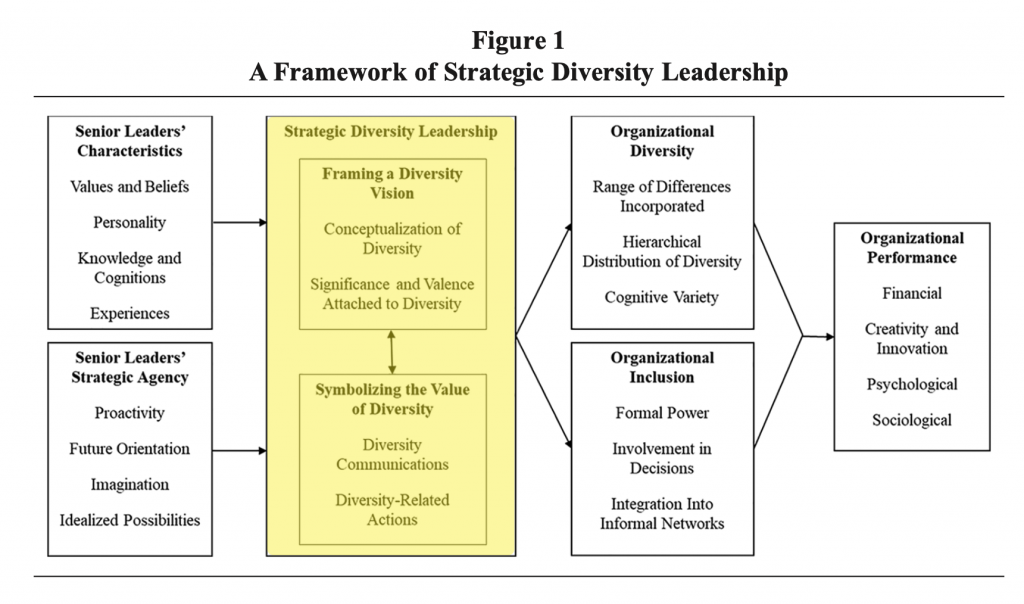Strategic Diversity Leadership
In “Strategic Diversity Leadership: The Role of Senior Leaders in Delivering the Diversity Dividend” (Journal of Management, September 2020), Luis L. Martins shines a spotlight on the role that top executives play in driving organizational performance through diversity and inclusion. In this paper, he discusses his findings from an extensive literature review of contemporary research, work that led him to develop a new framework he calls “strategic diversity leadership.” His purpose is to share this framework with organizational leaders who are seeking competitive advantage as well as his academic peers to inspire further study.
When Martins, a professor and chair of the management department at The University of Texas at Austin, finds a new way of solving a problem, it is worth taking a closer look. Over a 30-year academic career, he has conducted research and written extensively on the factors that drive innovation, change, and performance, including diversity and inclusion. He has also consulted for dozens of private- and public-sector clients to test solutions in the real world.
A missing link
There is a significant body of research that shows diversity leads to better organizational performance, but there is also evidence that shows the implementation of diversity and inclusion programs do not always lead to the desired results. Martins calls these desired results the diversity dividend, defined as “the enhancement in an organization’s performance that is attributable to its diversity” (1192). When he investigates why the diversity dividend is not realized, he discovers a missing link between the traditional role of top executives and the role they must play in their organization’s diversity and inclusion efforts. Martins argues that because senior leaders hold positions of authority, they have both the platform and the responsibility for realizing the benefits of a diverse workforce. If Martins is right, which I believe he is, implementing a strategic diversity leadership framework to close this gap is a key to better performance.

Leaders must lead
Martins defines strategic diversity leadership as “the shaping of the meaning of diversity within an organization by the organization’s senior leaders” (1194). To build his framework, Martins first asserts that senior leaders must frame a vision that not only defines diversity but also describes how inclusion will be used to distribute the power of diversity to benefit teams and the organization. Unfortunately, Martins describes the vision process in theoretical terms, but he does not expand these ideas by giving specific examples of how his ideas can be applied.
In the second part of his framework, however, Martins provides concrete suggestions to show how senior leaders can symbolize the value of diversity and inclusion. For example, he describes ways leaders can use the power of speeches and public statements to articulate that the “current state is unacceptable” (1198). He also suggests that senior leaders visibly participate in public activities that promote diversity and inclusion (1198-1199), including ceremonies, marches, and celebrations. In other words, top executives must “talk the talk” and “walk the walk.” While Martins does offer practical suggestions, he does not offer examples of organizations that are successfully implementing these ideas. His argument would be stronger if he could point to organizations and practices that can be emulated.
I believe that the strategic diversity leadership framework Martins proposes is useful because it shifts the focus for solving organizational culture challenges from the level of supervisors, staff, policies, and tasks to the level of executives, vision, strategy, and organizational design. Martins is telling us that those who hold the most power in an organization must be held accountable. I couldn’t agree more. Ultimately, I believe Martins’ strategic diversity framework will lead to positive results, but I also must point out that he stops short of holding top executives accountable for delivering on diversity and inclusion measurements in and of themselves. In my opinion, accountability for those measurements is a remaining gap in the framework. As a result, I think Martins misses an opportunity to raise diversity and inclusion to the level of other organizational commitments such as carbon neutrality or sustainability, for example.
Although the strategic diversity leadership framework holds great potential for bringing about change, Martins understands that he is breaking new ground and proposes further study to finetune his theories and reveal additional insights. I look forward with optimism to seeing his ideas confirmed and taken even further by way of more research and evidence from real-world situations.
Works Cited
Martins, Luis L. “Strategic Diversity Leadership: The Role of Senior Leaders in Delivering the Diversity Dividend.” Journal of Management, 1 September 2020, pp. 1191-1204, https://doi-org.libezproxy2.syr.edu/10.1177/0149206320939641.
“Luis Martins Biography.” The University of Texas at Austin, McCombs School of Business. https://www.mccombs.utexas.edu/execed/faculty/luis-martins.
